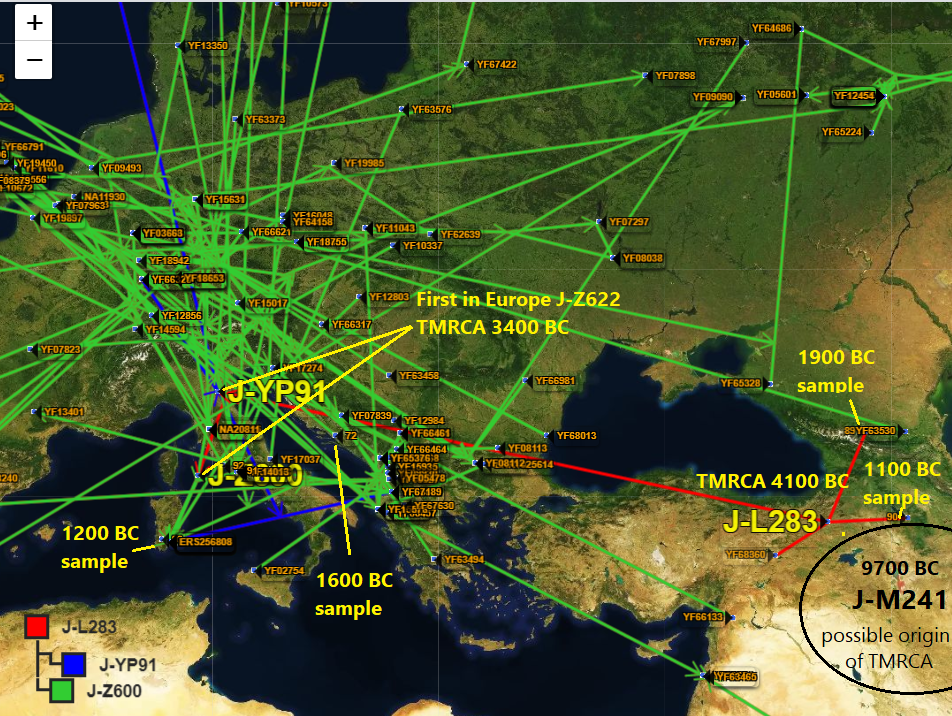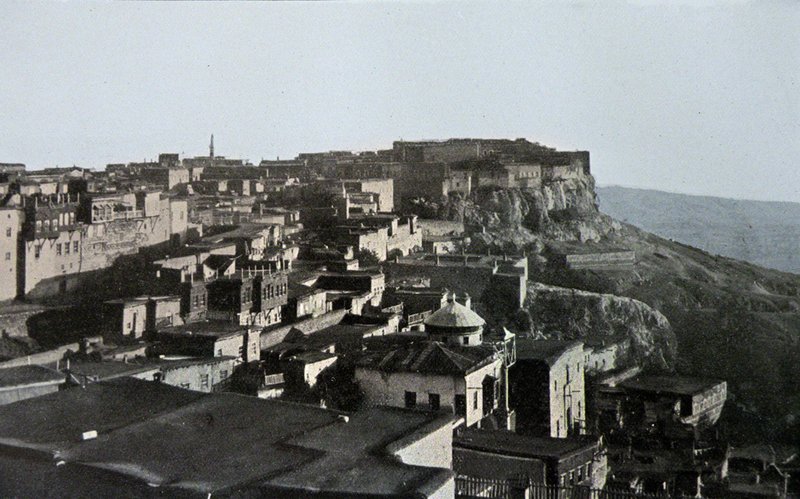A significant development in J-L283 research has occurred with the last YFull update (v8.00.00).
Background
Before the update this clade was a bottleneck starting 7700 BC and ending 3400 BC. While it is possible to estimate where the ancestor at the beginning and end of a bottleneck had been living based on upstream and downstream diversity, there is no genetic evidence pointing to where they were living in between.
The oldest J-L283 ancient sample was from the North Caucasus (Kabardino-Balkaria), but only dated to 1900 BC, it isn't old enough to conclude where the J-L283 common ancestor had been living in 3400 BC. But since this sample was negative for many of the important earliest mutations it hinted that the ancestors were living near the Caucasus.
Armenian Splits J-L283 3700 BC

A small window into the ancient origins of J-L283 opened up with the discovery that an Armenian man tracing descent to Harpoot tested positive for most J-L283 SNPs but negative for several.

In 3700 BC, the J-L283 most recent common ancestor had two sons. One son went on to become the Armenian from Harpoot. The other son sired a succession of men that for the next 300 years formed a bottleneck, now known as J-Z622, the living descendants of which trace descent to Europe.
If the modern Armenian J-L283* and the ancient samples from North and South Caucasus are circumstantial evidence that our J-L283 ancestors had been living in the Caucasus, then the 300 year J-Z622 bottleneck represents a migration from the Caucasus to Europe.
Archaeological Context - The Kura-Araxes Culture
To put this in an archaeological context, the most recent common ancestor of J-L283 lived around the beginning of the Kura-Araxes culture, which formed in the Ararat plain.
Interestingly, there is evidence that this culture migrated to the North Caucasus by 3000 BC (I do not have access to the original source of this information, cited by Wikipedia - Edens, Christoper (Aug–Nov 1995). "Transcaucasia at the End of the Early Bronze Age". Bulletin of the American Schools of Oriental Research. The American Schools of Oriental Research. 299/300 (The Archaeology of Empire in Ancient Anatolia): 54. JSTOR 1357345)
"Kura-Araxes culture is closely linked to the approximately contemporaneous Maykop culture of the North Caucasus. The two cultures seem to have influenced one another." - Wikipedia, Kura-Araxes
This recent paper, by Antonio Sagona, published in Paleorient in 2014, looks interesting. I intend to read it before examining the connection between J-L283 and Kura-Araxes in more depth.
I think it doesn't make sense to go into more detail here until additional living or older ancient J-L283 samples from the Caucasus / Near East join the YFull tree so we can get a better idea on geographical and time constraints.
J-Z622 Bottleneck : Possible Migration to Europe from 3700-3400 BC
The migration to Europe - again this is assuming a non-European origin of J-L283 which is just based on circumstantial evidence now - took a maximum of 300 years. We are actually very lucky to have such a precise range based on genetic evidence. The migration could have started anytime after 3700 BC and ended anytime before 3400 BC.
The Yamnaya are considered the most likely vector of the Ancestral North Eurasian autosomal component in modern Europeans. They contributed heavily genetically and culturally to the Corded Ware culture, one of the Final Neolithic cultures.
"Lazaridis et al. (2016) proposes a different people, likely from Iran, as the source for the Middle Eastern ancestry of the Yamnaya people, finding that "a population related to the people of the Iran Chalcolithic contributed ~43% of the ancestry of early Bronze Age populations of the steppe". - The Genetic Structure of the World's First Farmers
A connection to the Yamnaya or related groups around 3400 BC appears possible, though at this point based only on rough circumstantial evidence such as the above, on approximate dates and the fact that a J-L283 was found in the North Caucasus from 1900 BC. We will need to wait for more ancient and modern samples to get a clearer picture of how our ancestors entered Europe.
While J-Z600 diversified immediately in 3400 BC primarily around the Mediterranean but also siring two J-Z615* lineages from Germany and England, J-YP91 underwent a bottleneck until 2000 BC.
For all of our ancestors before the explosion of J-Z2507 in the Balkans 2400 BC, it was relatively hard times. We have relatively few survivors of these lineages. Sardinia and the Caucasus are known as genetic refugia because lineages which get replaced in more attractive or easy to reach areas are able to survive in relative geographic isolation. When invaders do enter they can escape by going into the mountains where they are less likely to be pursued.
The recent discovery of ancient NW European diversity within J-YP91 showed we were justified to regard Sardinia as a refuge of J-L283 lineages, rather than an origin of J-L283 itself. The ancient J-L283 from Sardinia points to one lineage of J-L283 having migrated there by 1200 BC, in line with a Bell Beaker mediated migration from Italy.
I've recently identified a Polish cluster of distantly related men who may be J-YP91. One of them plans to do NGS/WGS so hopefully we will learn more in the near future.
More likely than not, many of the answers we seek are already present in the DNA of J-M241 project members. We can make great strides in research by educating our members and showing them how fascinating the story of our ancestors is.
Anyone can become a haplogroup researcher and further this goal by encouraging their matches to test.
Hi. By 4100Bc, shulaveri were gone for 1000 years… What do they have to do with J-L283?
https://shulaverianhypothesis.blogs.sapo.pt/
The only source I can find easily online said it ended around 4000 BC.
https://en.wikipedia.org/wiki/Shulaveri-Shomu_culture
Can you reference a source for a different end date for Shulaveri Shomu? If so I can correct the article.
I mention it because the ending of the culture (4000 BC) coincides with the TMRCA of J-L283. I’m not making an assertion of what it means, just providing a relevant fact based on the info I found on Shulaveri Shomu.
Hi again. On Shulaveri Shomu, I am “the” source. 🙂
Seriously – As the first Shulaveri settlements appear by 6200BC, so all of them vanished suddenly by 5000BC… althought I like to use 4900BC. These days most sources always state 4900BC, because in fact both Shulaveri Gora and Mentesh tepe seem to be the last to go on that century.
Then for a while there seemed to be nothing there (Until around 4100BC, so 800 years at least, actually) and then we see the Sioni occupy the same region, but all very different than Shulaveri, architecture , ceramics, etc. As leilatepe appear in azerbaijan in a while the Sioni were engulfed by the the formation of the Kura-araxes culture at 3900BC.
Anyways, This confusion in wiki and other places is just…. confusing.
Thanks for letting me know about this. I will be more careful regarding using Wikipedia as a source going forward.
In any event, now that the YFull estimate for the J-L283 MRCA has bumped up a few hundred years to 3700 BC it is now clearly outside of the incorrect initial range I was using for Shulaveri Shomu.
I’ve edited the article with the new date estimates and replaced content about Shulaveri with Kura Araxes, which is more relevant.
Hunter
Hello,
I’m J-L283 with ancestry from Staffordshire England.
Not sure what to think about the implications as to my lineage.